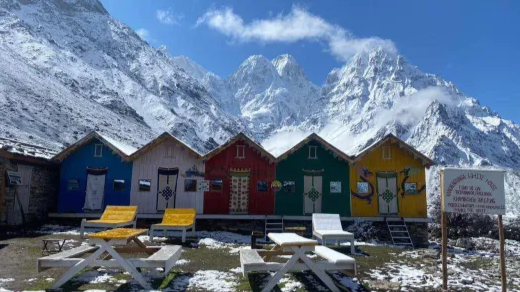In the remote far-eastern corner of Nepal, where the Himalayan giants meet the borders of India and Tibet, lies Kanchenjunga (8,586m)—the world’s third highest mountain and one of the most spectacular yet least-visited trekking destinations in Nepal. The Kanchenjunga Base Camp Trek offers an expedition-style adventure through pristine wilderness, crossing high passes, exploring both north and south base camps, and immersing trekkers in the cultures of Limbu, Rai, and Tibetan communities. This is Nepal’s most remote major trek, demanding significant time, physical fitness, and commitment, but rewarding adventurers with unparalleled solitude, dramatic scenery, and the profound satisfaction of exploring one of the Himalayas’ last true wilderness areas.
The Five Treasures of the Great Snows
Kanchenjunga’s name translates to “Five Treasures of the Great Snows,” referring to its five distinct peaks that contain treasures of gold, silver, gems, grain, and sacred books according to local legend. The mountain holds deep spiritual significance for the people of Sikkim and eastern Nepal, who consider it sacred and home to protective deities. This reverence influenced mountaineering history—when the first successful summit was achieved by a British expedition in 1955, climbers stopped just short of the actual summit out of respect for local beliefs, a tradition many climbers maintain today.
For trekkers, Kanchenjunga offers something increasingly rare in Nepal—genuine remoteness. The Kanchenjunga Conservation Area, established in 1997, protects 2,035 square kilometers of wilderness, making it Nepal’s largest protected area. The region sees fewer than a thousand trekkers annually, compared to tens of thousands on Everest routes, creating an experience closer to exploration than tourism.
The North and South Base Camp Circuit
The classic Kanchenjunga trek is actually two treks combined—visiting both the north base camp (Pang Pema) and south base camp (Oktang), creating a challenging circuit that typically requires 20-25 days. This duration makes it one of Nepal’s longest standard treks, demanding significant vacation time and physical endurance, but the commitment is richly rewarded with diverse landscapes and comprehensive exploration of the Kanchenjunga massif.
The journey begins with a flight from Kathmandu to Bhadrapur in the eastern Terai, followed by a long drive to Taplejung or beyond to trek starting points like Mitlung or Tapethok. Unlike treks beginning from mountain airstrips, the Kanchenjunga route starts at relatively low elevations (around 1,000m), meaning you’ll trek through every ecological zone from subtropical jungle to high-altitude glacial moraines.
The North Base Camp Route
The trail initially follows the Tamor River through terraced hillsides, traditional villages, and dense forests of rhododendron, oak, bamboo, and magnolia. The lower sections are lush and humid, especially during spring when rhododendrons explode in brilliant reds, pinks, and whites, creating one of the world’s finest floral displays. Villages like Chirwa, Sekathum, and Amjilosa represent traditional Limbu and Rai cultures, with stone houses, terraced agriculture, and Hindu temples marking this predominantly Hindu region.
As you climb toward Ghunsa (3,595m), the cultural landscape shifts dramatically. Ghunsa is a Tibetan Buddhist village where flat-roofed stone houses, chortens, prayer flags, and monasteries signal entry into the Himalayan Buddhist world. The village serves as a crucial acclimatization stop, with most trekkers spending two nights here before continuing higher. The local monastery, colorful prayer wheels, and warm hospitality of the Tibetan community make Ghunsa a trek highlight beyond its practical acclimatization function.
From Ghunsa, the trail climbs through alpine meadows and increasingly sparse vegetation to Khambachen (4,095m), where views of Jannu (7,710m) dominate the skyline with one of the Himalayas’ most dramatic north faces. The final push reaches Lhonak (4,780m) and ultimately Pang Pema (5,143m), the north base camp situated on the Kanchenjunga Glacier’s edge.
Pang Pema offers staggering mountain panoramas—Kanchenjunga’s massive north face towers above, while surrounding peaks including Mera Peak, Tent Peak, and the Nepal Peak complete a dramatic amphitheater of ice and rock. The glacier itself creates an otherworldly landscape of ice pinnacles, crevasses, and moraine ridges. Many trekkers spend extra days here, exploring higher viewpoints or simply absorbing the majesty of this remote location where few humans venture.
The South Base Camp Route
After returning to Ghunsa, the circuit continues south, crossing the challenging Sele La (4,290m) and Sinion La (4,660m) passes. These crossings require good fitness and favorable weather, with steep ascents, potentially icy conditions, and the altitude making every step demanding. The passes also mark a transition from the Ghunsa Valley to the Yalung Valley, offering spectacular views that make the effort worthwhile.
The south side trail passes through Tseram (3,870m), a seasonal settlement serving trekkers and yak herders, before reaching Ramze (4,580m) and ultimately Oktang (4,730m), the south base camp. Here, Kanchenjunga’s south face presents an entirely different character—steep, technical, and draped with massive hanging glaciers. The Yalung Glacier flows dramatically through the valley, and the surrounding peaks—Kabru, Rathong, and others—create another stunning mountain panorama.
Many trekkers ascend nearby viewpoints like Ramze viewpoint or push toward higher points on the moraine for even more spectacular perspectives. The sense of wilderness here is profound—you’re days from the nearest road, surrounded by some of Earth’s highest peaks, in a landscape that has witnessed minimal human presence.
Cultural Tapestry
The Kanchenjunga region’s cultural diversity adds tremendous depth to the trekking experience. The lower valleys are home to Limbu and Rai people, indigenous groups with distinct languages, traditions, and animist beliefs blended with Hinduism. Their stone houses with slate roofs, elaborate terrace systems, and production of traditional tongba (fermented millet beer) reflect centuries of mountain agriculture.
Higher elevations belong to Tibetan communities whose ancestors migrated across the Himalayas generations ago. Ghunsa and other high villages maintain pure Tibetan Buddhist culture—monasteries hold ancient texts and artwork, monks conduct daily prayers, and villagers practice traditions unchanged for centuries. The blend of animist, Hindu, and Buddhist beliefs creates fascinating cultural intersections, with locals often practicing elements of multiple traditions simultaneously.
Wilderness and Wildlife
The Kanchenjunga Conservation Area protects extraordinary biodiversity across its vast altitudinal range. The lower forests harbor red pandas, clouded leopards, Himalayan black bears, and over 250 bird species including the endangered spotted wren-babbler and satyr tragopan. Higher elevations support snow leopards, Himalayan tahr, blue sheep, and musk deer, though sightings require considerable luck given the terrain’s vastness and animals’ elusive nature.
The flora changes dramatically with altitude—subtropical forests transition to temperate mixed forests, then rhododendron forests that become famous during spring blooms, followed by juniper and birch scrubland, alpine meadows bursting with wildflowers in summer, and finally the barren, frozen landscapes above 4,500 meters where only the hardiest lichens survive.
Logistics and Challenges
The Kanchenjunga trek’s remoteness creates significant logistical considerations. It requires a restricted area permit, Kanchenjunga Conservation Area permit, and you must trek with a licensed guide—minimum two trekkers per guide. Permits cost approximately $20 per week, far less than Upper Mustang or Manaslu, reflecting the government’s intention to encourage visitation to this remote region.
Accommodation exists via basic tea houses in major villages and camps, but facilities are extremely simple—expect unheated rooms, shared pit toilets, limited menus, and no guarantees of hot water or electricity. In some locations, particularly at base camps, camping may be necessary. The remoteness means supplies are expensive and limited, so bringing adequate snacks, toiletries, and any special requirements is essential.
The trek’s length and altitude present serious challenges. You’ll spend multiple days above 4,000 meters, with base camps exceeding 5,000 meters. Proper acclimatization is absolutely critical, with built-in rest days at Ghunsa and other strategic locations. Acute Mountain Sickness is a real risk, and the remoteness complicates evacuation—helicopter rescue is possible but expensive and weather-dependent.
Weather can be unpredictable and severe. Snow can fall at high elevations any time of year, making passes dangerous or impassable. The region receives significant monsoon rainfall, and even in optimal seasons, clouds and precipitation can occur. Flexibility in your itinerary is essential.
Physical Demands
This trek demands excellent physical fitness and significant trekking experience. Daily distances can be long, elevation gains steep, and the cumulative effects of altitude, duration, and basic conditions test even experienced trekkers. The crossing of Sele La and Sinion La passes requires stamina, proper gear, and sometimes navigating snow and ice. Previous high-altitude trekking experience is strongly recommended.
Best Trekking Seasons
Autumn (late September-November) offers the most reliable weather, clear mountain views, and stable trail conditions. Post-monsoon clarity provides spectacular photography, though temperatures are cold at higher elevations and passes may have snow.
Spring (March-May) is equally popular, offering warmer conditions and the spectacular rhododendron blooms that make the lower forests legendary. However, afternoon clouds can obscure mountain views, and late-season warmth increases avalanche risks.
Winter (December-February) sees very few trekkers—extreme cold, heavy snow blocking passes, and most tea houses closed make it suitable only for expeditions with full camping support. Summer monsoon (June-August) brings heavy rainfall, leeches, landslides, and obscured views, making it the least favorable season.
Why Trek Kanchenjunga?
The Kanchenjunga Base Camp Trek appeals to experienced trekkers seeking the ultimate Himalayan adventure. It offers everything that made Nepal famous—towering peaks, diverse cultures, challenging passes, pristine wilderness—while maintaining the remote, exploratory character that most regions have lost. The commitment required in time and effort naturally filters out casual trekkers, creating a self-selected community of serious adventurers.
The sense of achievement from completing this trek exceeds most other Nepal routes. You’ve explored both sides of the world’s third highest mountain, crossed challenging passes, spent weeks in genuine wilderness, and visited places few people ever see. The combination of spectacular scenery, cultural richness, physical challenge, and true remoteness creates an experience that represents Himalayan trekking at its most authentic and rewarding.
Conclusion
The Kanchenjunga Base Camp Trek tands as Nepal’s ultimate wilderness adventure—long, challenging, remote, and absolutely spectacular. It demands significant commitment, excellent fitness, proper preparation, and acceptance of basic conditions, but rewards those willing to make the investment with experiences that rival anything the Himalayas offer. This is trekking as exploration, where you’re genuinely off the beaten path, where mountain views are earned through days of effort, where cultural encounters feel authentic because tourism hasn’t transformed traditional lifestyles. For experienced trekkers ready to push beyond classic routes into true wilderness, Kanchenjunga represents the pinnacle of Himalayan adventure—a journey into the far corners of Nepal where the mountains still hold their mysteries and the trails lead to places that feel genuinely remote, wild, and magnificent.



